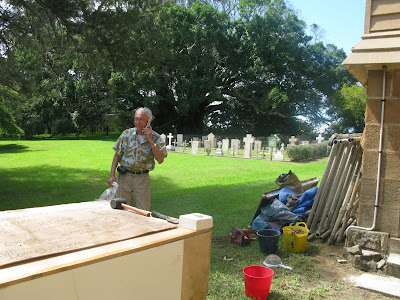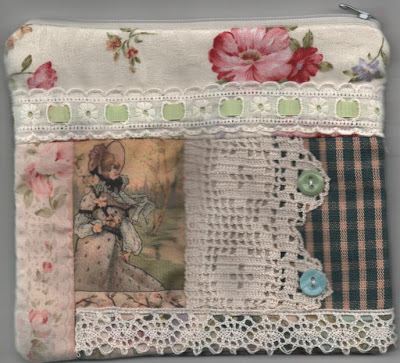The Melanesian Chapel of St Barnabas, on Norfolk Island, is probably one of the most beautiful and most visited historic buildings in all the islands of the South Pacific. Visitors to Norfolk Island are often surprised to find a little church in this remote place with an inspiring beauty and charm that is usually found in great cathedrals.
It was in 1871 that the much loved Bishop Patteson was martyred at Nukapu in the Solomons, when he was mistaken for a "blackbirder' who had come to take young boys away to sugar plantations in Australia and Fiji. His death actually served as a catalyst to bring about an end to this "slave trade". However, there was also great sadness and mourning throughout the Christian world at the loss of this fine man, still in his early forties.
It was decided to build a chapel to his memory. Many of Patteson's colleagues and family back in England decided to subscribe to a fund build a fitting memorial, fulfilling a vision that the Bishop himself had witten about of "... beautiful Gothic Chapel, rich inside with marble and stained glass, and carved stalls and encaustic tiles and brass screen work...It may come some day, and most probably, long after I am dead and gone."
The building was designed by Sir Graham Jackson, a well-known British architect, and the work was carried out under the supervision of Dr Robert Codrington, who was the manager of the Mission set up on Norfolk Island.
The building was to be of stone, which supported a soaring timber framework for the steep roof. For the main walls of the building, they used blocks of limestone which were quarried from the west side of Emily Bay on the south side of the island, and dragged the fiive kilometres to the Chapel site using bullock drays.
However, for the interior, particularly in the Chancel area, Codrington decided to lay alternate courses of local limestone and the lighter and more mellow Oamaru stone which was imported from the South Island of New Zealand, arriving in 1878. At the time, Codrington noted in a letter home how ironic it was that it was actually cheaper to bring that Oamaru stone by steamer all the way from New Zealand than it was to purchase the local stone!
The Chapel was consecrated on 7th December 1880, with great celebrations and festivities, which were enjoyed by up to fifty visitors mostly from New Zealand.
St Barnabas' Chapel was handed over for use by the Church of England on Norfolk Island in 1920, when the Melanesian Mission moved its headquarters to the Solomons.
It is a much treasured building, not only by the parishioners but the whole island, who take great pride in this beautiful icon.
It is, however, a mammoth task to maintain and preserve this valuable building. To this end, the church established a branch organisation called the "Friends of St Barnabas'" some years ago. the idea was that "The Friends" would devote their efforts to raising funds and carrying out necessary restoration projects, thus allowing the Church council itself to focus on ministry matters.
The restoration work is constant and ongoing, and this picture here shows the work that is currently being carried out on the timber work surrounding the William Morris Rose window, stripping back to the raw timber and repairing and replacing any rotting areas.
Recently, The Friends of St Barnabas decided it was time to tackle restoration work on the Oamaru stone, which was crumbling somewhat in the Sanctuary area. The problem was not new. In fact, back in 1930, Henry Drummond wrote in a report that the stone was deteriorating and although attempts had been made to arrest the problem, they had not been successful. It would appear that the main problem was the proximity of the locally quarried limestone, which contained salt and which reacted with the sandstone.
The Friends of St Barnabas attempted to contact someone who knew about Oamaru Stone, and fortuitously Bill Dooley himself, the owner and manager of Dooley Masonry in Oamaru, would soon be honeymooning on Norfolk Island, and would be able to inspect the problem itself.
Bill arranged to send replacement stone to Norfolk Island, and at first he hoped to instruct some local tradesmen to actually carry out the work. However, this did not eventuate, and two or three years later, in March of 2011, Bill and his wife returned themselves with two of their workers, and carried out the task.
I should point out that the deterioration in the stone was not particularly unsightly, nor was it hazardous. The main problem was the stone dust that the church cleaners had to deal with each week! Moreover, it was advisable to deal with it before it did present more severe problems.This dust came from the restoration process - much worse than the weekly deposits the church cleaners encountered, but it is very white and really shows up.
Bill Dooley and his team got stuck into the job, and soon had it all looking as good as new, Along the way they discovered other problems needing attention, such as dampness and drainage, which they were able to point out to "The Friends" and the Parish Council.As well as the salt problem, Bill felt that the instability may have been partly caused by the direction in which the Oamaru stone was laid. He said that it should always be positioned facing the same vertical direction in which it had been quarried.
There used to be wall hangings in this sanctuary area, which were removed and laundered before the work was carried out. However, they proved to be in such bad condition, it was decided not to put them back.
Now everyone commented on how lovely it looked without them. You can now see the beauty of the stonework, and the sanctuary area was so light and airy! These beautiful windows, the work of Sir Edward Burne-Jones, seem to greatly enhanced.
Keeping our precious "Father Willis" organ in good condition and tune is another important responsibility we have as caretakers of this lovely church.
Things were in a bit of disarray while the work was being carried out, but Bill and the boys soon had it looking better than ever. In fact, Bill, obviously a man of great practical skills, even showed us how to fix this old vacuum cleaner that has been out of commission for some time! I should add that Mr Dooley has, on his own admission, reached his four score years, so we were very blessed to benefit from his enormous skills and expertise.
Bill also has quite a sense of humour, and I could not resist photographing the labels on the crate that had brought the stone from New Zealand.
I think you will agree that our Chapel of St Barnabas is a very special building, set in magnificent grounds, and well worth the effort of keeping it in a beautiful condition for present and future generations to enjoy. Last year we replaced the roof at a cost of around $200 000, and in the near future we will need to attend to the Devonshire marble floor, which has many loose tiles. Currently, a thorough stripping and re-painting of all the exterior timber is being carried out.
You will note from the picture above that St Barnabas' is built in the "school chapel" style, with seats facing each other across a central aisle. Most important is that the Chapel is a house of worship to this day, and as we express our faith and God's love in this place, we are mindful of that much-loved Bishop, of the faithful Mission workers, of the Melanesian students who gathered here, and of all those who have gone before us who have been inspired by this very lovely place.
An Afterthought
I have just remembered this little Oamaru stone vase, given to us by friends a few years ago. I note on the base of this vase it says it has been "silicone treated". Now I must admit I have sometimes wondered about the wisdom of replacing sandstone with the same thing, which may continue to react with the adjacent limestone. I think this is the answer, and I do recall Bill Dooley talking about "silicone" when we discussed the project with him!
An Afterthought
I have just remembered this little Oamaru stone vase, given to us by friends a few years ago. I note on the base of this vase it says it has been "silicone treated". Now I must admit I have sometimes wondered about the wisdom of replacing sandstone with the same thing, which may continue to react with the adjacent limestone. I think this is the answer, and I do recall Bill Dooley talking about "silicone" when we discussed the project with him!






























































